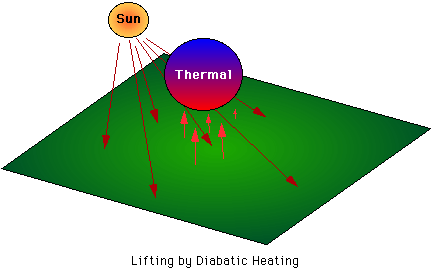|
|
Diabatic HeatingWe have mentioned many times how the radiation emitted by the earth heats the air at the surface. When the warm air rises, it may cool adiabatically, meaning without the exchange of heat between the parcel and the surrounding air. The temperature drops in response to the change in pressure. In contrast, we refer to the heating that occurs by the radiation as diabatic heating. Diabatic is the opposite of adiabatic. In the case of diabatic heating, the temperature of the air changes, at least in part, in response to the heat that is added by radiation. The air expands as it warms, making it less dense than its environment. Because less dense materials are more buoyant, the warmer air rises producing a thermal.
 Confused? Have a question? If so, check out the Frequently Asked Questions (FAQ) page or send mail to the OS411 tutor (os411tutor@shodor.org) with your question! Report technical/content problems here |
|
|